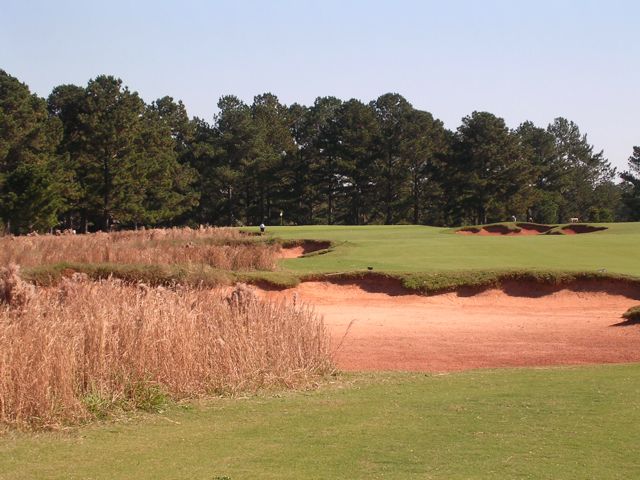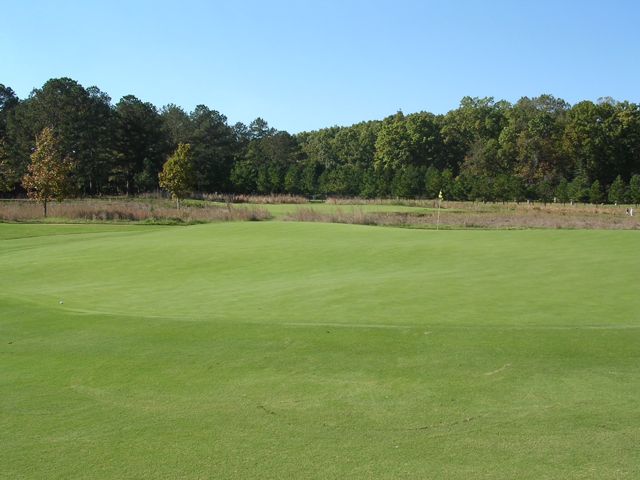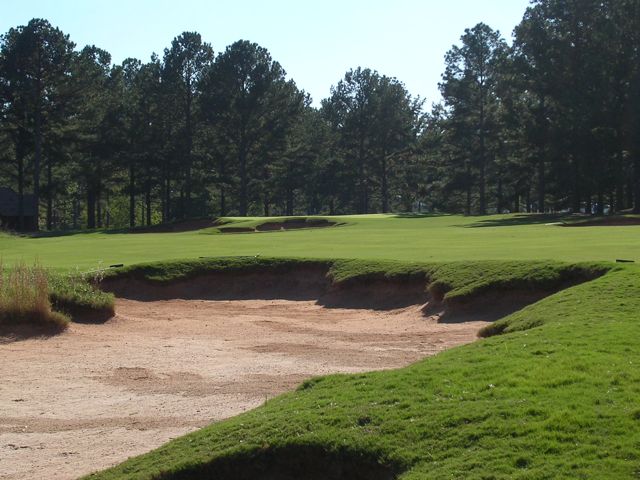
With several different lines of play, the opening tee shot at Cuscowilla is one of the most tantalizing in the state.
How much do lakes and other large bodies of water influence our perception of golf holes? Do we tend to overvalue holes, or courses, if they have big water backdrops, or does water make golf better or at least more exciting? How does one separate scenery from a hole’s intrinsic merits?
This is a philosophical matter, not to mention a subjective one. Certainly a hole can have both aesthetic and strategic value, but how you answer will go far in determining your opinion of The Golf Club at Cuscowilla, on Lake Oconee in central Georgia.
The Cuscowilla property is a mix of meadows and sections of an old pine nursery that slopes from higher ground on three sides toward the nooks and inlets of Lake Oconee. When Bill Coore and Ben Crenshaw began walking the site it occurred to them that the best land for golf was primarily on the higher, inland sections of the site and not along the low shoreline of the lake. To be ceded the views of the water up-front was a developer’s dream. Most architects would fight for more lakefront holes, but most architects don’t build holes and courses the way Coore and Crenshaw do.
That was even truer in 1997. The architects has just returned from the Sand Hills site where they mastered the art of reading the land and building the most natural holes a property could afford. Cuscowilla was nowhere are rich as what they’d just spent several years indulged in, but the drive to build with minimum alteration to the land led them inexorably away from the water and into the more rolling, nuanced upper terrain.
This is context for why really only the 10th and 11th holes at Cuscowilla touch the lake when so much shoreline was available. It’s a notable contrast to Great Waters, the course Jack Nicklaus built at Reynolds Lake Oconee that’s visible across the water from parts of the Cuscowilla property. There, Nicklaus placed nine holes along the shore.
That contrast draws out distinctions about the role of water and what makes holes inspiring. One architectural team saw it as central and did everything it could to get down to the shore–in fact eight of Great Waters’ lake holes are on the inward nine–while the other did everything it could to get away from it. How you respond to that also says a lot about what you value in a golf course.
Cuscowilla’s opening six holes are, in my opinion, as good as any in the southeast. The tempo and variety is perfect, with open holes like the first presenting differing lines of play off the tee depending on your courage level, segueing to a tighter par-5 where trees and several well-placed bunkers encourage you to shape shots left and right. There’s a daunting pair of holes with demanding tee shots across ponds, a drivable par-4 with alternate fairways and a 465-yard monster across a breezy meadow.
The second great run begins at the par-4 15th, a hole that starts in trees then prods upward into an enclosed meadow that serves as the arena for the final four holes. It’s green is the most interesting on the course, with swales and swells running all over it, and when standing there you’re at the center of a magnificent 360-degree golf gallery that includes panoramas of the par-3 16th and par-4 17th as well as portions of the 485-yard closer.
Cuscowilla passes all the noble Coore and Crenshaw tests: it’s got width, multiplicity, sublimity, an instinctive communion with the site and the ground, low and natural appearing putting surfaces and fearsome bunkering. If there’s any weakness, it’s the property itself–while good enough to inspire holes like 1-6 and 15-18, it’s also responsible for holes like 10 and 11, 13, and particularly 14, a rather bizarre and incontinent uphill par-5 with a tortuously sloped green.
Truthfully, Cuscowilla would be better if the lake weren’t there at all. It doesn’t need it, and the detour over the inlet where it does interject itself breaks a pleasurable momentum more than it enhances excitement. And that’s probably the best testament to how good the course really is: the lake is superfluous to the wonderful golf. The same certainly couldn’t be said about Great Waters or any of Cuscowilla’s other neighbors. (93)
Eatonton/Lake Oconee
Architects: Bill Coore and Ben Crenshaw
Year: 1997




